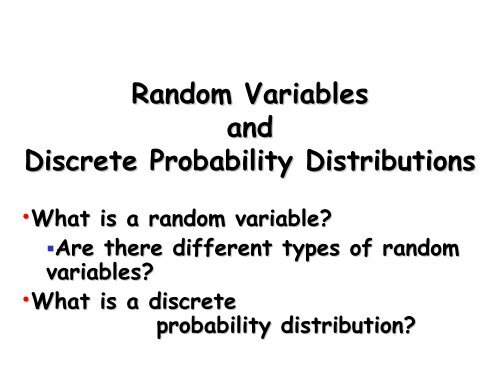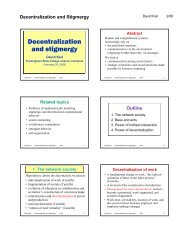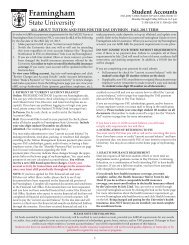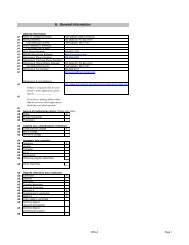Random Variables and Discrete Probability Distributions
Random Variables and Discrete Probability Distributions
Random Variables and Discrete Probability Distributions
You also want an ePaper? Increase the reach of your titles
YUMPU automatically turns print PDFs into web optimized ePapers that Google loves.
<strong>R<strong>and</strong>om</strong> <strong>Variables</strong><br />
<strong>and</strong><br />
<strong>Discrete</strong> <strong>Probability</strong> <strong>Distributions</strong><br />
•What What is a r<strong>and</strong>om variable?<br />
��Are Are there different types of r<strong>and</strong>om<br />
variables?<br />
•What What is a discrete<br />
probability distribution?
<strong>R<strong>and</strong>om</strong> Variable<br />
• A r<strong>and</strong>om variable is a variable that<br />
takes on values associated with<br />
outcomes of a probability<br />
experiment.<br />
�� The values of a r<strong>and</strong>om variable<br />
are numerical values/measures<br />
that are either discrete or<br />
continuous.
<strong>R<strong>and</strong>om</strong> Variable<br />
• A r<strong>and</strong>om variable is a variable that<br />
takes on values associated with<br />
outcomes of a probability<br />
experiment.<br />
�� <strong>R<strong>and</strong>om</strong> variables are denoted<br />
using letters such as X.
<strong>R<strong>and</strong>om</strong> Variable<br />
• A discrete r<strong>and</strong>om variable has<br />
either a finite number of values or<br />
a countable number of values.
<strong>R<strong>and</strong>om</strong> Variable<br />
• A discrete r<strong>and</strong>om variable has<br />
either a finite number of values or<br />
a countable number of values.<br />
• Examples:<br />
�� The number displayed on the top<br />
face of a fair die<br />
�� The prizes associated with a<br />
raffle
<strong>R<strong>and</strong>om</strong> Variable<br />
• A discrete r<strong>and</strong>om variable has<br />
either a finite number of values or<br />
a countable number of values.<br />
• Examples:<br />
�� The number of times a fair coin<br />
l<strong>and</strong>s tail side up when the coin is<br />
tossed five times
<strong>R<strong>and</strong>om</strong> Variable<br />
• A discrete r<strong>and</strong>om variable has<br />
either a finite number of values or<br />
a countable number of values.<br />
• Examples:<br />
�� The sum of the numbers displayed<br />
on the top faces of a pair of fair<br />
dice
<strong>R<strong>and</strong>om</strong> Variable<br />
• A discrete r<strong>and</strong>om variable has<br />
either a finite number of values or<br />
a countable number of values.<br />
• Examples:<br />
�� The number of customers waiting<br />
in line to be served at a<br />
Starbucks
<strong>R<strong>and</strong>om</strong> Variable<br />
• A discrete r<strong>and</strong>om variable has<br />
either a finite number of values or<br />
a countable number of values.<br />
• Examples:<br />
�� The amounts, in dollars, of the<br />
prizes associated with a winning<br />
Massachusetts Daily Number<br />
lottery ticket
<strong>R<strong>and</strong>om</strong> Variable<br />
• A discrete r<strong>and</strong>om variable has<br />
either a finite number of values or<br />
a countable number of values.<br />
• Examples:<br />
�� The number of French Fries in a<br />
small order of French Fries<br />
purchased at Burger Burger King<br />
King
<strong>R<strong>and</strong>om</strong> Variable<br />
• A continuous r<strong>and</strong>om variable has an<br />
infinite number of values.
<strong>R<strong>and</strong>om</strong> Variable<br />
• A continuous r<strong>and</strong>om variable has an<br />
infinite number of values.<br />
• Examples:<br />
�� The amount of time, in minutes,<br />
it takes a student to complete a<br />
one-hour one hour examination
<strong>R<strong>and</strong>om</strong> Variable<br />
• A continuous r<strong>and</strong>om variable has an<br />
infinite number of values.<br />
• Examples:<br />
�� The amount of water, in ounces,<br />
in an 8-ounce 8 ounce bottle of Pol<strong>and</strong> Pol<strong>and</strong><br />
Springs Springs bottled water
<strong>R<strong>and</strong>om</strong> Variable<br />
• A continuous r<strong>and</strong>om variable has an<br />
infinite number of values.<br />
• Examples:<br />
�� The amount of water, in gallons,<br />
that flows over Niagara Falls<br />
during one hour
<strong>R<strong>and</strong>om</strong> Variable<br />
• A continuous r<strong>and</strong>om variable has an<br />
infinite number of values.<br />
• Examples:<br />
�� The weight, in ounces, of a Big Big<br />
Mac Mac sold at McDonald’’ss<br />
McDonald
<strong>R<strong>and</strong>om</strong> Variable<br />
• A continuous r<strong>and</strong>om variable has an<br />
infinite number of values.<br />
• Examples:<br />
�� The weight, in pounds, for the<br />
amount of red seedless grapes<br />
that you buy while shopping at<br />
Stop Stop & & Shop<br />
Shop
<strong>Probability</strong> Distribution for a<br />
<strong>Discrete</strong> <strong>R<strong>and</strong>om</strong> Variable<br />
• A probability distribution for a<br />
discrete r<strong>and</strong>om variable X is a<br />
table, table,<br />
graph, graph,<br />
or formula formula that<br />
specifies the probability associated<br />
with each possible value of the<br />
r<strong>and</strong>om variable.
<strong>Probability</strong> Distribution for a<br />
<strong>Discrete</strong> <strong>R<strong>and</strong>om</strong> Variable<br />
• Since probabilities are between<br />
zero <strong>and</strong> one, inclusive, the values<br />
of the probabilities associated with<br />
a discrete r<strong>and</strong>om variable must be<br />
between zero <strong>and</strong> one, inclusive.
<strong>Probability</strong> Distribution for a<br />
<strong>Discrete</strong> <strong>R<strong>and</strong>om</strong> Variable<br />
• Since probabilities are between zero <strong>and</strong><br />
one, inclusive, the values of the<br />
probabilities associated with a discrete<br />
r<strong>and</strong>om variable must be between zero<br />
<strong>and</strong> one, inclusive. inclusive<br />
�� Letting P(x) P(x)<br />
denote the probability<br />
that the value of the r<strong>and</strong>om<br />
variable X is equal to x, these<br />
probabilities must be such that<br />
0 ≤ P(x) P(x)<br />
≤ 1
<strong>Probability</strong> Distribution for a<br />
<strong>Discrete</strong> <strong>R<strong>and</strong>om</strong> Variable<br />
• Since probabilities are between zero <strong>and</strong><br />
one, inclusive, the values of the<br />
probabilities associated with a discrete<br />
r<strong>and</strong>om variable must be between zero<br />
<strong>and</strong> one, inclusive. inclusive<br />
�� Alternate: Alternate:<br />
Letting P(X = x) denote<br />
the probability that the value of<br />
the r<strong>and</strong>om variable X is equal to x,<br />
these probabilities must be such<br />
that 0 ≤ P(X = x) ≤ 1
<strong>Probability</strong> Distribution for a<br />
<strong>Discrete</strong> <strong>R<strong>and</strong>om</strong> Variable<br />
• Since all the probabilities<br />
associated with the values of the<br />
r<strong>and</strong>om variable are specified by<br />
the probability distribution, the sum<br />
of these probabilities must be one.<br />
�� Letting P(x) P(x)<br />
denote the probability that the<br />
value of the r<strong>and</strong>om variable X is equal to<br />
x, these probabilities must be such<br />
∑ P(x) P(x)<br />
= 1
<strong>Probability</strong> Distribution for a<br />
<strong>Discrete</strong> <strong>R<strong>and</strong>om</strong> Variable<br />
• Since all the probabilities<br />
associated with the values of the<br />
r<strong>and</strong>om variable are specified by<br />
the probability distribution, the sum<br />
of these probabilities must be one.<br />
�� Alternate: Alternate: Letting P(X = x) denote the<br />
probability that the value of the r<strong>and</strong>om<br />
variable X is equal to x, these probabilities<br />
must be such<br />
∑ P(X = x) = 1
<strong>Probability</strong> Distribution for a<br />
<strong>Discrete</strong> <strong>R<strong>and</strong>om</strong> Variable<br />
• Requirements for a probability<br />
distribution for a discrete r<strong>and</strong>om<br />
variable<br />
�� For P(x) P(x)<br />
the probability that the<br />
value of the r<strong>and</strong>om variable X is<br />
equal to x, the following must be<br />
true:<br />
�� 0 ≤ P(x) P(x)<br />
≤ 1<br />
�� ∑ P(x) P(x)<br />
= 1
<strong>Probability</strong> Distribution for a<br />
<strong>Discrete</strong> <strong>R<strong>and</strong>om</strong> Variable<br />
• Alternate Alternate Notation Notation -- Requirements<br />
for a probability distribution for a<br />
discrete r<strong>and</strong>om variable<br />
�� For P(X = x) the probability that<br />
the value of the r<strong>and</strong>om variable X<br />
is equal to x, the following must be<br />
true:<br />
�� 0 ≤ P(X = x) ≤ 1<br />
�� ∑ P(X = x) = 1
What is the probability distribution<br />
for the toss of one fair coin?
What is the probability distribution<br />
for the toss of one fair coin?<br />
• It would be best to use a table to<br />
represent the probability<br />
distribution for the toss of a fair<br />
coin.
What is the probability distribution<br />
for the toss of one fair coin?<br />
• First, we must determine the<br />
possible outcomes for tossing a fair<br />
coin.
What is the probability distribution<br />
for the toss of one fair coin?<br />
• First, we must determine the<br />
possible outcomes for tossing a fair<br />
coin.<br />
• The possible outcomes are for the<br />
coin to l<strong>and</strong> head side up or tail<br />
side up.
What is the probability distribution<br />
for the toss of one fair coin?<br />
• Let Heads denote the coin l<strong>and</strong>ing<br />
head side up.<br />
• Let Tails denote the coin l<strong>and</strong>ing<br />
tail side up.
What is the probability distribution<br />
for the toss of one fair coin?<br />
• Second, we must determine the<br />
probability associated with each<br />
outcome.
What is the probability distribution<br />
for the toss of one fair coin?<br />
• Second, we must determine the<br />
probability associated with each<br />
outcome.<br />
• The probability that the coin l<strong>and</strong>s<br />
head side up is ½.<br />
• The probability that the coin l<strong>and</strong>s<br />
tail side up is ½.
What is the probability distribution<br />
for the toss of one fair coin?<br />
• P(Heads) P(Heads)<br />
= ½<br />
• P(Tails) P(Tails)<br />
= ½<br />
• Using the alternate notation<br />
�� P(X = Heads) = ½<br />
�� P(X = Tails) = ½
What is the probability distribution<br />
for the toss of one fair coin?<br />
• Finally, we set up the table. We<br />
create this table in a similar<br />
manner to the way in which we<br />
create frequency distributions <strong>and</strong><br />
relative frequency distributions.<br />
�� Put the values of the variable in<br />
the first column
What is the probability distribution<br />
for the toss of one fair coin?<br />
• Finally, we set up the table. We<br />
create this table in a similar<br />
manner to the way in which we<br />
create frequency distributions <strong>and</strong><br />
relative frequency distributions.<br />
�� Put the corresponding<br />
probabilities in the second column
What is the probability<br />
distribution for the toss of one<br />
fair coin?<br />
x P(x) P(x<br />
Heads ½<br />
Tails ½
What is the probability<br />
distribution for the toss of one<br />
fair coin?<br />
x P(x) P(x<br />
Heads ½<br />
Tails ½<br />
Don’t Don t forget the title! Otherwise, the reader<br />
will not underst<strong>and</strong> what your table represents.
What is the probability<br />
distribution for the toss of one<br />
fair coin?<br />
<strong>Probability</strong> Distribution for the<br />
Toss of a Fair Coin<br />
x P(x) P(x<br />
Heads ½<br />
Tails ½
What is the probability<br />
distribution for the toss of one<br />
fair coin?<br />
Using Using the the alternate alternate notation<br />
notation<br />
<strong>Probability</strong> Distribution for the<br />
Toss of a Fair Coin<br />
x P(X = x)<br />
Heads ½<br />
Tails ½
What is the probability<br />
distribution for the toss of one<br />
fair coin?<br />
• If we change the point of view<br />
from Heads <strong>and</strong> Tails to the<br />
number of Heads then the values of<br />
the r<strong>and</strong>om variable are numerical.<br />
�� Heads becomes 1 since there is<br />
one Head.<br />
�� Tails becomes 0 since there are<br />
zero Heads.
What is the probability<br />
distribution for the toss of one<br />
fair coin?<br />
Using Using a a different different point point of of view view --<br />
<strong>Probability</strong> Distribution for the<br />
Number of Heads for the Toss of a Fair Coin<br />
x P(x) P(x<br />
1 ½<br />
0 ½
What is the probability<br />
distribution for the toss of one<br />
fair coin?<br />
Using Using a a different different point point of of view view --<br />
<strong>Probability</strong> Distribution for the<br />
Number of Heads for the Toss of a Fair Coin<br />
x P(X = x)<br />
1 ½<br />
0 ½
What is the probability distribution<br />
for the roll of one fair die?
What is the probability distribution<br />
for the roll of one fair die?<br />
• First, we must determine the values<br />
of the r<strong>and</strong>om variable.
What is the probability distribution<br />
for the roll of one fair die?<br />
• First, we must determine the values<br />
of the r<strong>and</strong>om variable.<br />
�� That is, what are the possible<br />
outcomes for the roll of a fair<br />
die?
What is the probability distribution<br />
for the roll of one fair die?<br />
• That is, what are the possible<br />
outcomes for the roll of a fair die?<br />
�� Let the outcomes be represented<br />
by the number of dots displayed<br />
on the top face of the die when<br />
it l<strong>and</strong>s.
What is the probability distribution<br />
for the roll of one fair die?<br />
• The possible outcomes for the roll<br />
of a fair die are<br />
�� 1<br />
�� 2<br />
�� 3<br />
�� 4<br />
�� 5<br />
�� 6
What is the probability distribution<br />
for the roll of one fair die?<br />
• Next, we must determine the<br />
associated probability for each<br />
value of the r<strong>and</strong>om variable.
What is the probability distribution<br />
for the roll of one fair die?<br />
• Next, we must determine the<br />
associated probability for each<br />
value of the r<strong>and</strong>om variable.<br />
�� That is, we must determine the<br />
associated probability for each<br />
outcome.
What is the probability distribution<br />
for the roll of one fair die?<br />
• For this experiment, the associated<br />
probability for each outcome is<br />
1/6.
What is the probability distribution<br />
for the roll of one fair die?<br />
• Finally, we create the table.<br />
Again, this table is set up in a<br />
similar manner to the frequency<br />
distribution <strong>and</strong> the relative<br />
frequency distribution tables.
What is the probability distribution<br />
for the roll of one fair die?<br />
• Finally, we create the table.<br />
Again, this table is set up in a<br />
similar manner to the frequency<br />
distribution <strong>and</strong> the relative<br />
frequency distribution tables.<br />
�� Values of variable in first column<br />
�� Associated probabilities in second<br />
column
What is the probability distribution<br />
for the roll of one fair die?<br />
x P(x) P(x<br />
1 1/6<br />
2 1/6<br />
3 1/6<br />
4 1/6<br />
5 1/6<br />
6 1/6
What is the probability distribution<br />
for the roll of one fair die?<br />
x P(x) P(x<br />
1 1/6<br />
2 1/6<br />
3 1/6<br />
4 1/6<br />
5 1/6<br />
6 1/6<br />
Don’t Don t forget the title! Otherwise, the reader will<br />
not underst<strong>and</strong> what your table represents.
What is the probability distribution<br />
for the roll of one fair die?<br />
<strong>Probability</strong> Distribution for the Roll of a Fair Die<br />
x P(x) P(x<br />
1 1/6<br />
2 1/6<br />
3 1/6<br />
4 1/6<br />
5 1/6<br />
6 1/6
What is the probability distribution<br />
for the roll of one fair die?<br />
Using Using the the alternate alternate notation<br />
notation<br />
<strong>Probability</strong> Distribution for the Roll of a Fair Die<br />
x P(X = x)<br />
1 1/6<br />
2 1/6<br />
3 1/6<br />
4 1/6<br />
5 1/6<br />
6 1/6
Did you notice that each example<br />
meets the requirements for a<br />
discrete r<strong>and</strong>om variable???
Did you notice that each example<br />
meets the requirements for a<br />
discrete r<strong>and</strong>om variable???<br />
What are those???
Did you notice that each example<br />
meets the requirements for a<br />
discrete r<strong>and</strong>om variable???<br />
• Requirements for a probability<br />
distribution for a discrete r<strong>and</strong>om<br />
variable<br />
�� For P(x) P(x)<br />
the probability that the value of<br />
the r<strong>and</strong>om variable X is equal to x, the<br />
following must be true:<br />
�� 0 ≤ P(x) P(x)<br />
≤ 1<br />
�� ∑ P(x) P(x)<br />
= 1
Requirements for a probability<br />
distribution for a discrete r<strong>and</strong>om<br />
variable must be met!<br />
• If P(x) P(x)<br />
is not not such that 0 ≤ P(x) P(x)<br />
≤ 1 <strong>and</strong> <strong>and</strong><br />
∑ P(x) P(x)<br />
= 1 then your table, graph, or<br />
formula does not not represent a probability<br />
distribution for a discrete r<strong>and</strong>om variable.
Requirements for a probability<br />
distribution for a discrete r<strong>and</strong>om<br />
variable must be met!<br />
• If P(x) P(x)<br />
is not not such that 0 ≤ P(x) P(x)<br />
≤ 1 <strong>and</strong> <strong>and</strong><br />
∑ P(x) P(x)<br />
= 1 then your table, graph, or<br />
formula does not not represent a probability<br />
distribution for a discrete r<strong>and</strong>om variable.<br />
Carefully notice the “<strong>and</strong> <strong>and</strong>”!! !! Both conditions<br />
must be met!!!
Requirements for a probability<br />
distribution for a discrete r<strong>and</strong>om<br />
variable must be met!<br />
• Alternate Alternate Notation Notation ––<br />
If P(X = x) is not not such that<br />
0 ≤ P(X = x) ≤ 1 <strong>and</strong> <strong>and</strong> ∑ P(X = x) = 1 then<br />
your table, graph, or formula does not not<br />
represent a probability distribution for a<br />
discrete r<strong>and</strong>om variable.
Requirements for a probability<br />
distribution for a discrete r<strong>and</strong>om<br />
variable must be met!<br />
• Alternate Alternate Notation Notation ––<br />
If P(X = x) is not not such that<br />
0 ≤ P(X = x) ≤ 1 <strong>and</strong> <strong>and</strong> ∑ P(X = x) = 1 then<br />
your table, graph, or formula does not not<br />
represent a probability distribution for a<br />
discrete r<strong>and</strong>om variable.<br />
Carefully notice the “<strong>and</strong> <strong>and</strong>”!! !! Both conditions<br />
must be met!!!
Did you notice that if the<br />
examples meet the requirements<br />
for a discrete r<strong>and</strong>om variable???
Did you notice that if the<br />
examples meet the requirements<br />
for a discrete r<strong>and</strong>om variable???<br />
They They do!<br />
do!
Did you notice that if the<br />
examples meet the requirements<br />
for a discrete r<strong>and</strong>om variable???<br />
Check Check each each for for yourself!
Did you notice that if the<br />
examples meet the requirements<br />
for a discrete r<strong>and</strong>om variable???<br />
Check Check each each for for yourself!<br />
For each example, the individual<br />
probabilities are between zero <strong>and</strong><br />
one, inclusive, <strong>and</strong> <strong>and</strong> the sum of the<br />
probabilities is one.
Notation<br />
• For clarity, we will use the alternate alternate<br />
notation notation in the rest of these slides.<br />
�� Reminder: P(X = x) denotes the<br />
probability that the value of the r<strong>and</strong>om<br />
variable X is equal to x
Does the table below represent a<br />
probability distribution for a<br />
discrete r<strong>and</strong>om variable?<br />
x P(X = x)<br />
Penny 0.13<br />
Nickel 0.22<br />
Dime 0.38<br />
Quarter -0.29 0.29<br />
Dollar 0.56
Does the table below represent a<br />
probability distribution for a<br />
discrete r<strong>and</strong>om variable?<br />
x P(X = x)<br />
Penny 0.13<br />
Nickel 0.22<br />
Dime 0.38<br />
Quarter -0.29 0.29<br />
Dollar 0.56<br />
NO! Although the<br />
sum of the values in<br />
the P(X = x) column<br />
is one, none of these<br />
values can be<br />
negative if these<br />
values are to be<br />
probabilities.
Does the table below represent a<br />
probability distribution for a<br />
discrete r<strong>and</strong>om variable?<br />
x P(X = x)<br />
Penny 0.13<br />
Nickel 0.22<br />
Dime 0.38<br />
Quarter -0.29 0.29<br />
Dollar 0.56<br />
NO! Although the<br />
sum of the values in<br />
the P(X = x) column<br />
is one, none of these<br />
values can be<br />
negative if these<br />
values are to be<br />
probabilities.<br />
Note: No title is provided since this is a generic example.
Does the table below represent a<br />
probability distribution for a<br />
discrete r<strong>and</strong>om variable?<br />
x P(X = x)<br />
-2 0.25<br />
1 0.3<br />
3 0.4<br />
5 0.05
Does the table below represent a<br />
probability distribution for a<br />
discrete r<strong>and</strong>om variable?<br />
x P(X = x)<br />
-2 0.25<br />
1 0.3<br />
3 0.4<br />
5 0.05<br />
YES! The values in<br />
the P(X = x) column<br />
are each between<br />
zero <strong>and</strong> one,<br />
inclusive <strong>and</strong> the sum<br />
of these values is<br />
one.
Does the table below represent a<br />
probability distribution for a<br />
discrete r<strong>and</strong>om variable?<br />
x P(X = x)<br />
-2 0.25<br />
1 0.3<br />
3 0.4<br />
5 0.05<br />
YES! The values in<br />
the P(X = x) column<br />
are each between<br />
zero <strong>and</strong> one,<br />
inclusive inclusive <strong>and</strong> the sum<br />
of these values is<br />
one.<br />
Note: There are no<br />
limitations on the x<br />
values.<br />
Note: No title is provided since this is a generic example.
Does the table below represent a<br />
probability distribution for a<br />
discrete r<strong>and</strong>om variable?<br />
x P(X = x)<br />
2 0.23<br />
4 0.3<br />
6 0.4<br />
8 0.05<br />
10 0.01
Does the table below represent a<br />
probability distribution for a<br />
discrete r<strong>and</strong>om variable?<br />
x P(X = x)<br />
2 0.23<br />
4 0.3<br />
6 0.4<br />
8 0.05<br />
10 0.01<br />
NO! Although the<br />
values in the P(X = x)<br />
column are each<br />
between zero <strong>and</strong> one,<br />
inclusive, inclusive,<br />
the sum of<br />
these values is NOT<br />
one.<br />
Note: No title is provided since this is a generic example.
<strong>Probability</strong> Histogram<br />
• We construct a probability<br />
histogram in the same way in which<br />
we construct a frequency histogram<br />
or a relative frequency histogram<br />
except with probability on the<br />
vertical axis rather than frequency<br />
or relative frequency, respectively.
<strong>Probability</strong> Histogram<br />
• As with a frequency histogram or a<br />
relative frequency histogram, the<br />
axes must be appropriately labeled<br />
<strong>and</strong> there must be an appropriate<br />
title.
Raffle Example<br />
• A raffle has four prizes, a first<br />
prize of $500, a second prize of<br />
$200, two third prizes of $50, <strong>and</strong><br />
three fourth prizes of $10. Suppose<br />
1000 tickets are sold for $1 each.<br />
• Create the discrete probability<br />
distribution for someone who purchases<br />
one ticket for this raffle.
Raffle Example<br />
• Although there are four prizes, there<br />
are five five possible outcomes<br />
�� Win First prize of $500<br />
�� Win Second prize of $200<br />
�� Win Third prize of $50<br />
�� Win Fourth prize of $10<br />
�� Not winning one of these prizes,<br />
“winning winning” $0
Raffle Example<br />
• Since not not winning winning one one of of the the prizes prizes<br />
cannot be named as a “prize prize”, , it would<br />
be best to represent the outcomes as<br />
using the value, in dollars, for each<br />
prize.
Raffle Example<br />
• Since not not winning winning one one of of the the prizes prizes<br />
cannot be named as a “prize prize”, , it would<br />
be best to represent the outcomes as<br />
using the value, in dollars, for each<br />
prize.<br />
�� The outcomes are $500, $200, $50,<br />
$10, <strong>and</strong> $0.
Raffle Example<br />
• Next, we determine the probability<br />
that each outcome occurs.
Raffle Example<br />
• Next, we determine the probability<br />
that each outcome occurs.<br />
�� P(X = $500) = 1/1000 since there is<br />
one prize of $500 <strong>and</strong> one thous<strong>and</strong><br />
tickets were sold.
Raffle Example<br />
• Next, we determine the probability<br />
that each outcome occurs.<br />
�� P(X = $200) = 1/1000 since there is<br />
one prize of $200 <strong>and</strong> one thous<strong>and</strong><br />
tickets were sold.
Raffle Example<br />
• Next, we determine the probability<br />
that each outcome occurs.<br />
�� P(X = $50) = 2/1000 since there are<br />
two prizes of $50 <strong>and</strong> one thous<strong>and</strong><br />
tickets were sold.
Raffle Example<br />
• Next, we determine the probability<br />
that each outcome occurs.<br />
�� That is, P(X = $50) = 1/500 since<br />
there are two prizes of $50 <strong>and</strong> one<br />
thous<strong>and</strong> tickets were sold.
Raffle Example<br />
• Next, we determine the probability<br />
that each outcome occurs.<br />
�� P(X = $10) = 3/1000 since there are<br />
three prizes of $10 <strong>and</strong> one<br />
thous<strong>and</strong> tickets were sold.
Raffle Example<br />
• Next, we determine the probability<br />
that each outcome occurs.<br />
�� P(X = $0) = 993/1000 since there<br />
are 993 prizes of $0, that is, there<br />
are 993 non-winning non winning tickets, <strong>and</strong> one<br />
thous<strong>and</strong> tickets were sold.
Raffle Example<br />
• Finally, we compile the information into<br />
a table
Raffle Example<br />
• Finally, we compile the information into<br />
a table that that includes includes a a meaningful<br />
meaningful<br />
title.<br />
title.
Raffle Example<br />
<strong>Probability</strong> Distribution for the Prizes, in dollars, that<br />
a Person who Buys One $1-Raffle $1 Raffle Ticket could win in a<br />
Raffle for which One-Thous<strong>and</strong> One Thous<strong>and</strong> Tickets are Sold<br />
x P(X = x)<br />
500 1/1000<br />
200 1/1000<br />
50 1/500<br />
10 3/1000<br />
0 993/1000
Raffle Example<br />
• In our previous analysis, we focused<br />
on the prizes prizes for the raffle.<br />
�� Point of view used – Prize Prize<br />
• Thus, our probability distribution<br />
was for the prizes prizes for the raffle.
Raffle Example<br />
• We do not need to focus on the<br />
prizes.
Raffle Example<br />
• We could focus on the amount of<br />
money that one wins.<br />
wins
Raffle Example<br />
• Winnings Winnings for a raffle are not the<br />
same as the prizes prizes for the raffle.<br />
�� Winnings Winnings are what you get in<br />
excess of what you had before<br />
you purchased the ticket.
Raffle Example<br />
• Winnings Winnings for a raffle are not the<br />
same as the prizes prizes for the raffle.<br />
�� Winnings Winnings are what you get in<br />
excess of what you had before<br />
you purchased the ticket.<br />
• Let us consider the winnings winnings … .
Raffle Example<br />
• Alternate Alternate point point<br />
of view – Winnings<br />
Winnings
Raffle Example<br />
• Alternate Alternate point point<br />
of view – Winnings Winnings<br />
�� If you win first prize <strong>and</strong> you paid $1<br />
for your ticket, you actually win win $499<br />
�� Amount of Winnings<br />
= Amount of Prize – Ticket Price<br />
�� First Prize Winnings = $500 - $1
Raffle Example<br />
• Alternate Alternate point point<br />
of view – Winnings Winnings<br />
�� If you win second prize <strong>and</strong> you paid<br />
$1 for your ticket, you actually win win<br />
$199<br />
�� Amount of Winnings<br />
= Amount of Prize – Ticket Price<br />
�� Second Prize Winnings = $200 - $1
Raffle Example<br />
• Alternate Alternate point point<br />
of view – Winnings Winnings<br />
�� If you win third prize <strong>and</strong> you paid<br />
$1 for your ticket, you actually win win<br />
$49<br />
�� Amount of Winnings<br />
= Amount of Prize – Ticket Price<br />
�� Third Prize Winnings = $50 - $1
Raffle Example<br />
• Alternate Alternate point point<br />
of view – Winnings Winnings<br />
�� If you win fourth prize <strong>and</strong> you paid<br />
$1 for your ticket, you actually win win<br />
$9<br />
�� Amount of Winnings<br />
= Amount of Prize – Ticket Price<br />
�� Fourth Prize Winnings = $10 - $1
Raffle Example<br />
• Alternate Alternate point point<br />
of view – Winnings Winnings<br />
�� If you do not win a prize <strong>and</strong> you paid<br />
$1 for your ticket, you actually win win<br />
--$1 $1<br />
�� Amount of Winnings<br />
= Amount of Prize – Ticket Price<br />
�� Winnings for a Losing Losing Ticket<br />
= $0 - $1
Raffle Example<br />
• Combining this information into a table<br />
with an appropriate <strong>and</strong> meaningful<br />
title, we obtain the probability<br />
distribution for this raffle from a point<br />
of view of the winnings winnings for someone who<br />
purchases a ticket.
Raffle Example<br />
<strong>Probability</strong> Distribution for the Winnings, in dollars,<br />
for a Person who Buys One $1-Raffle $1 Raffle Ticket for a<br />
Raffle for which One-Thous<strong>and</strong> One Thous<strong>and</strong> Tickets are Sold<br />
x P(X = x)<br />
499 1/1000<br />
199 1/1000<br />
49 1/500<br />
9 3/1000<br />
-1 993/1000
Raffle Example<br />
• Note: The point of view does not<br />
affect the probabilities or the<br />
number of outcomes.<br />
�� The point of view only affects<br />
how the values of the r<strong>and</strong>om<br />
variable are represented.
Raffle Example<br />
• Note: The r<strong>and</strong>om variables for<br />
this example (based on the point of<br />
view) are related but not the same<br />
since<br />
Prize ≠ Winnings.
Raffle Example<br />
• Did you notice that our probability<br />
distributions for each point of view<br />
meet the requirements for discrete<br />
probability distributions?
Raffle Example<br />
• Did you notice that our probability<br />
distributions for each point of view<br />
meet the requirements for discrete<br />
probability distributions?<br />
• They do! Check them for yourself!
Raffle Example<br />
• Did you notice that our probability<br />
distributions for each point of view<br />
meet the requirements for discrete<br />
probability distributions?<br />
• For each, our values of P(X = x) are<br />
such that<br />
�� 0 ≤ P(X = x) ≤ 1 <strong>and</strong> <strong>and</strong> ∑ P(X = x) = 1
Expected Value for a<br />
<strong>Discrete</strong> <strong>R<strong>and</strong>om</strong> Variable
Expected Value for a<br />
<strong>Discrete</strong> <strong>R<strong>and</strong>om</strong> Variable<br />
• The mean of a discrete r<strong>and</strong>om variable<br />
X, denoted μX, , is determined using the<br />
formula<br />
μX = ∑[x x · P(X = x)].
Expected Value for a<br />
<strong>Discrete</strong> <strong>R<strong>and</strong>om</strong> Variable<br />
• The mean of a discrete r<strong>and</strong>om variable<br />
X, denoted μX, , is determined using the<br />
formula<br />
μX = ∑[x x · P(X = x)].<br />
• That is, to determine μX, , we take the<br />
sum of the product of the values of the<br />
r<strong>and</strong>om variable, x, <strong>and</strong> their<br />
corresponding probabilities, P(X = x).
Expected Value for a<br />
<strong>Discrete</strong> <strong>R<strong>and</strong>om</strong> Variable<br />
• The mean of a discrete r<strong>and</strong>om variable<br />
X, denoted μX, , also referred to as the<br />
expected value.
Expected Value for a<br />
<strong>Discrete</strong> <strong>R<strong>and</strong>om</strong> Variable<br />
• The mean of a discrete r<strong>and</strong>om variable<br />
X, denoted μX, , also referred to as the<br />
expected value.<br />
Why?
Expected Value for a<br />
<strong>Discrete</strong> <strong>R<strong>and</strong>om</strong> Variable<br />
• The mean of a discrete r<strong>and</strong>om variable<br />
X, denoted μX, , also referred to as the<br />
expected value.<br />
• The mean, or expected value, also<br />
denoted E(X), is that value that we<br />
would expect expect the r<strong>and</strong>om variable to<br />
attain in the long run.
Expected Value for a<br />
<strong>Discrete</strong> <strong>R<strong>and</strong>om</strong> Variable<br />
• The mean of a discrete r<strong>and</strong>om variable<br />
X, denoted μX, , also referred to as the<br />
expected value.<br />
• We can think of μX = E(X) as the mean<br />
value of a very large (infinite, if we<br />
could) number of repetitions of the<br />
experiment in which the values of X<br />
occur in proportions equivalent to the<br />
probabilities of X.
Expected Value for a<br />
<strong>Discrete</strong> <strong>R<strong>and</strong>om</strong> Variable<br />
• We can think of μX = E(X) as the<br />
average value of the r<strong>and</strong>om variable<br />
that we would expect to obtain if we<br />
perform the experiment repeatedly.<br />
�� Letting xk represent the outcome of<br />
the k th repetition of the experiment,<br />
[x 1 + x 2 + … + xk + … + xn]/n ]/n gets<br />
closer to μX = E(X) as the number of<br />
repetitions of the experiment, n,<br />
increases in value.
How many Heads should we expect<br />
if we toss two fair coins?
How many Heads should we expect<br />
if we toss two fair coins?<br />
• First, we must determine the sample<br />
space for the experiment.<br />
�� HH<br />
�� HT<br />
�� TH<br />
�� TT
How many Heads should we expect<br />
if we toss two fair coins?<br />
• Next, we count the outcomes.<br />
�� The outcome two Heads, HH, occurs<br />
once.<br />
�� The outcome one Head, HT <strong>and</strong> TH,<br />
occurs twice.<br />
�� The outcome zero Heads, TT, occurs<br />
once.
How many Heads should we expect<br />
if we toss two fair coins?<br />
• Next, we create the probability<br />
distribution.
How many Heads should we<br />
expect if we toss two fair<br />
coins?<br />
<strong>Probability</strong> Distribution for the Toss<br />
of Two Fair Coins<br />
x P(X = x)<br />
0 ¼<br />
1 ½<br />
2 ¼
How many Heads should we expect<br />
if we toss two fair coins?<br />
• Finally, having determined the<br />
probability distribution, we can<br />
calculate the expected number of<br />
Heads, that is, the expected value for<br />
the number of Heads.<br />
μX = E(X) = 0·(¼) 0 ) + 1·(½) 1 ) + 2·(¼) 2 )<br />
= ½ + ½<br />
= 1
How many Heads should we expect<br />
if we toss two fair coins?<br />
• μX = E(X) = 0·(¼) 0 ) + 1·(½) 1 ) + 2·(¼) 2 )<br />
= ½ + ½<br />
= 1<br />
• We can expect one Head if we toss<br />
two fair coins.
What is the expected value for<br />
the roll of a fair die?
What is the expected value for<br />
the roll of a fair die?<br />
• We have already created the<br />
probability distribution for the roll of<br />
a fair die.
What is the expected value for<br />
the roll of a fair die?<br />
<strong>Probability</strong> Distribution for the Roll of a Fair Die<br />
x P(X = x)<br />
1 1/6<br />
2 1/6<br />
3 1/6<br />
4 1/6<br />
5 1/6<br />
6 1/6
What is the expected value for<br />
the roll of a fair die?<br />
• So, we calculate the expected value by<br />
taking the sum of the products of the<br />
values of the r<strong>and</strong>om variable <strong>and</strong><br />
their corresponding probabilities.
What is the expected value for<br />
the roll of a fair die?<br />
= E(X) = 1(1/6) + 2(1/6) + 3(1/6)<br />
+ 4(1/6) + 5(1/6) + 6(1/6)<br />
= (1 + 2 + 3 + 4 + 5 + 6)/6<br />
= 21/6<br />
= 3.5<br />
• μ X = E(X) = 1(1/6) + 2(1/6) + 3(1/6)
What is the expected value for<br />
the roll of a fair die?<br />
• μX = E(X) = 1(1/6) + 2(1/6) + 3(1/6)<br />
+ 4(1/6) + 5(1/6) + 6(1/6)<br />
= (1 + 2 + 3 + 4 + 5 + 6)/6<br />
= 21/6<br />
= 3.5<br />
• Notice that the expected value is not<br />
one of the possible outcomes for the<br />
r<strong>and</strong>om variable.
What is the expected prize<br />
for our raffle example?
What is the expected prize<br />
for our raffle example?<br />
• We have already created the probability<br />
distribution for our raffle.
What is the expected prize<br />
for our raffle example?<br />
<strong>Probability</strong> Distribution for the Prizes, in dollars, that<br />
a Person who Buys One $1-Raffle $1 Raffle Ticket could win in a<br />
Raffle for which One-Thous<strong>and</strong> One Thous<strong>and</strong> Tickets are Sold<br />
x P(X = x)<br />
500 1/1000<br />
200 1/1000<br />
50 1/500<br />
10 3/1000<br />
0 993/1000
What is the expected prize<br />
for our raffle example?<br />
• Using our probability distribution, we<br />
can calculate the expected prize for<br />
someone purchasing one ticket for our<br />
raffle.
What is the expected prize<br />
for our raffle example?<br />
• μX = E(X) = 500(1/1000) + 200(1/1000)<br />
+ 50(2/1000) + 10(3/1000)<br />
+ 0(993/1000)<br />
= (500 + 200 + 100 + 30)/1000<br />
= 830/1000<br />
= 0.83<br />
• The expected prize for someone buying a<br />
ticket for our raffle is $0.83.
What are the expected winnings<br />
for our raffle example?
What are the expected winnings<br />
for our raffle example?<br />
• We have already created the probability<br />
distribution for our raffle.
What are the expected winnings<br />
for our raffle example?<br />
<strong>Probability</strong> Distribution for the Winnings, in dollars,<br />
for a Person who Buys One $1-Raffle $1 Raffle Ticket for a<br />
Raffle for which One-Thous<strong>and</strong> One Thous<strong>and</strong> Tickets are Sold<br />
x P(X = x)<br />
499 1/1000<br />
199 1/1000<br />
49 1/500<br />
9 3/1000<br />
-1 993/1000
What are the expected winnings<br />
for our raffle example?<br />
• Using our probability distribution, we<br />
can calculate the expected winnings for<br />
someone purchasing one ticket for our<br />
raffle.
What are the expected winnings<br />
for our raffle example?<br />
• μX = E(X) = 499(1/1000) + 199(1/1000)<br />
+ 49(2/1000) + 9(3/1000)<br />
+ (-1)(993/1000)<br />
( 1)(993/1000)<br />
= (499 + 199 + 98<br />
+ 27 - 993)/1000<br />
= -170/1000 170/1000<br />
= -0.17 0.17<br />
• The expected winnings for someone buying<br />
a ticket for our raffle is -$0.17. $0.17.
What are the expected winnings<br />
for our raffle example?<br />
• μX = E(X) = 499(1/1000) + 199(1/1000)<br />
+ 49(2/1000) + 9(3/1000)<br />
+ (-1)(993/1000)<br />
( 1)(993/1000)<br />
= (499 + 199 + 98<br />
+ 27 - 993)/1000<br />
= -170/1000 170/1000<br />
= -0.17 0.17<br />
• The expected winnings for someone buying<br />
a ticket for our raffle is -$0.17. $0.17. WHAT<br />
WHAT??
What are the expected winnings<br />
for our raffle example?<br />
• μX = E(X) = 499(1/1000) + 199(1/1000)<br />
+ 49(2/1000) + 9(3/1000)<br />
+ (-1)(993/1000)<br />
( 1)(993/1000)<br />
= (499 + 199 + 98<br />
+ 27 - 993)/1000<br />
= -170/1000 170/1000<br />
= -0.17 0.17<br />
• Someone buying a ticket for our raffle can<br />
expect to lose $0.17.
For our raffle example, can we use<br />
our expected prize calculation to<br />
determine the expected winnings?
For our raffle example, can we use<br />
our expected prize calculation to<br />
determine the expected winnings?<br />
• Yes, we can.
For our raffle example, can we use<br />
our expected prize calculation to<br />
determine the expected winnings?<br />
• Since we know that the expected prize<br />
for someone buying a ticket for our raffle<br />
is $0.83, all we have to do is take into<br />
account her/his having paid $1 for the<br />
ticket.
For our raffle example, can we use<br />
our expected prize calculation to<br />
determine the expected winnings?<br />
• Since we know that the expected prize<br />
for someone buying a ticket for our raffle<br />
is $0.83, all we have to do is take into<br />
account her/his having paid $1 for the<br />
ticket.<br />
�� Recall:<br />
Winnings = Value of Prize – Cost of Ticket
For our raffle example, can we use<br />
our expected prize calculation to<br />
determine the expected winnings?<br />
• Since we know that the expected prize<br />
for someone buying a ticket for our raffle<br />
is $0.83, all we have to do is take into<br />
account her/his having paid $1 for the<br />
ticket.<br />
• Expected Winnings = Expected Prize - $1<br />
= 0.83 – 1<br />
= -0.17 0.17
For our raffle example, can we use<br />
our expected prize calculation to<br />
determine the expected winnings?<br />
• Expected Winnings = Expected Prize - $1<br />
= 0.83 – 1<br />
= -0.17 0.17<br />
• Again, we find that someone buying a<br />
ticket for our raffle can expect to lose<br />
$0.17.
Variance <strong>and</strong> St<strong>and</strong>ard Deviation for<br />
a <strong>Discrete</strong> <strong>R<strong>and</strong>om</strong> Variable
Variance <strong>and</strong> St<strong>and</strong>ard Deviation for<br />
a <strong>Discrete</strong> <strong>R<strong>and</strong>om</strong> Variable<br />
• The variance of a discrete r<strong>and</strong>om<br />
variable X, denoted σ2 X = Var(X), Var(X),<br />
is<br />
determined using the formula<br />
σ2 X = Var(X)= Var(X)=<br />
∑[( [(x x – μX) 2 · P(X = x)]<br />
= ∑[x2 · P(X = x)] – (μX ) 2<br />
• The st<strong>and</strong>ard deviation of a discrete<br />
r<strong>and</strong>om variable X, denoted σX, , is the<br />
square root of the variance.
What is the st<strong>and</strong>ard deviation for<br />
the number displayed on the<br />
top face of a fair die?
What is the st<strong>and</strong>ard deviation for<br />
the number displayed on the<br />
top face of a fair die?<br />
• We have already created the<br />
probability distribution for the roll of<br />
a fair die.
What is the st<strong>and</strong>ard deviation for<br />
the number displayed on the<br />
top face of a fair die?<br />
<strong>Probability</strong> Distribution for the Roll of a Fair Die<br />
x P(X = x)<br />
1 1/6<br />
2 1/6<br />
3 1/6<br />
4 1/6<br />
5 1/6<br />
6 1/6
What is the st<strong>and</strong>ard deviation for<br />
the number displayed on the<br />
top face of a fair die?<br />
• We have already calculated the<br />
expected value.<br />
• Recall:<br />
�� μX = E(X) = 1(1/6) + 2(1/6) + 3(1/6)<br />
+ 4(1/6) + 5(1/6) + 6(1/6)<br />
= (1 + 2 + 3 + 4 + 5 + 6)/6<br />
= 21/6<br />
= 3.5
What is the st<strong>and</strong>ard deviation for<br />
the number displayed on the<br />
top face of a fair die?<br />
• So, we can calculate the variance,<br />
�� σ2 X = (1-3.5) (1 3.5) 2 (1/6) + (2-3.5) (2 3.5) 2 (1/6)<br />
+ (3-3.5) (3 3.5) 2 (1/6) + (4-3.5) (4 3.5) 2 (1/6)<br />
+ (5-3.5) (5 3.5) 2 (1/6) + (6-3.5) (6 3.5) 2 (1/6)<br />
= (-2.5) ( 2.5) 2 (1/6) + (-1.5) ( 1.5) 2 (1/6)<br />
+ (-0.5) ( 0.5) 2 (1/6) + (0.5) 2 (1/6)<br />
+ (1.5) 2 (1/6) + (2.5) 2 (1/6)<br />
= 2(6.25 + 2.25 + 0.25)/6<br />
= 35/12
What is the st<strong>and</strong>ard deviation for<br />
the number displayed on the<br />
top face of a fair die?<br />
• Then, taking the square root of the<br />
variance, we determine the st<strong>and</strong>ard<br />
deviation,<br />
�� σX = √(35/12) (35/12)<br />
≈ 1.707825228<br />
≈ 1.707
What is the st<strong>and</strong>ard deviation for<br />
the number displayed on the<br />
top face of a fair die?<br />
• Or, using the other variance formula,<br />
�� σ2 X = [1 2 (1/6) + 2 2 (1/6) + 3 2 (1/6)<br />
+ 4 2 (1/6) + 5 2 (1/6)<br />
+ 6 2 (1/6)] – (3.5) 2<br />
= [(1 + 4 + 9 + 16<br />
+ 25 + 36)/6] – 49/4<br />
= 91/6 – 49/4<br />
= (182 – 147)/12<br />
= 35/12
What is the st<strong>and</strong>ard deviation for<br />
the number displayed on the<br />
top face of a fair die?<br />
• Again, the st<strong>and</strong>ard deviation is<br />
�� σX = √(35/12) (35/12)<br />
≈ 1.707825128<br />
≈ 1.707
What is the st<strong>and</strong>ard deviation for<br />
the number of Heads for the<br />
toss of two fair coins?
What is the st<strong>and</strong>ard deviation for<br />
the number of Heads for the<br />
toss of two fair coins?<br />
• We have already created the<br />
probability distribution for the toss of<br />
two fair coins.
What is the st<strong>and</strong>ard deviation for<br />
the number of Heads for the<br />
toss of two fair coins?<br />
<strong>Probability</strong> Distribution for the Toss<br />
of Two Fair Coins<br />
x P(X = x)<br />
0 ¼<br />
1 ½<br />
2 ¼
What is the st<strong>and</strong>ard deviation for<br />
the number of Heads for the<br />
toss of two fair coins?<br />
• We have already determined the<br />
expected number of heads for the toss<br />
of two fair coins.<br />
• Recall:<br />
�� μX = E(X) = 0·(¼) 0 ) + 1·(½) 1 ) + 2·(¼) 2 )<br />
= ½ + ½<br />
= 1
What is the st<strong>and</strong>ard deviation for<br />
the number of Heads for the<br />
toss of two fair coins?<br />
• So, we can calculate the st<strong>and</strong>ard<br />
deviation.<br />
�� σ2 X = (0-1) (0 1) 2 ·(¼) ) + (1-1) (1 1) 2 ·(½) )<br />
+ (2-1) (2 1) 2 ·(¼) )<br />
= ¼ + ¼<br />
= ½<br />
�� σX = √(½)<br />
≈ 0.707 Heads
What is the st<strong>and</strong>ard deviation for<br />
the number of Heads for the<br />
toss of two fair coins?<br />
• Or, using the other formula,
What is the st<strong>and</strong>ard deviation for<br />
the number of Heads for the<br />
toss of two fair coins?<br />
• we can calculate the st<strong>and</strong>ard<br />
deviation, again.<br />
�� σ2 X = [(0) 2 ·(¼) ) + (1) 2 ·(½) )<br />
+ (2) 2 ·(¼)] )] – (1)<br />
= [½ [ + 1] - 1<br />
= ½<br />
�� σX = √(½)<br />
≈ 0.707 Heads<br />
(1) 2
Variance <strong>and</strong> St<strong>and</strong>ard Deviation for<br />
a <strong>Discrete</strong> <strong>R<strong>and</strong>om</strong> Variable<br />
• Note: The second formula,<br />
σ2 X = Var(X)= Var(X<br />
)= ∑[x2 · P(X = x)] – (μX ) 2<br />
is easier/quicker to use than the first,<br />
σ2 X = Var(X)= Var(X)=<br />
∑[( [(x x – μX) 2 · P(X = x)]<br />
However, it does not matter which one<br />
we use.
Variance <strong>and</strong> St<strong>and</strong>ard Deviation for<br />
a <strong>Discrete</strong> <strong>R<strong>and</strong>om</strong> Variable<br />
• Note: The second formula,<br />
σ2 X = Var(X)= Var(X<br />
)= ∑[x2 · P(X = x)] – (μX ) 2<br />
is easier/quicker to use than the first,<br />
σ2 X = Var(X)= Var(X)=<br />
∑[( [(x x – μX) 2 · P(X = x)]<br />
However, it does not matter which one<br />
we use.<br />
It is your choice.

















